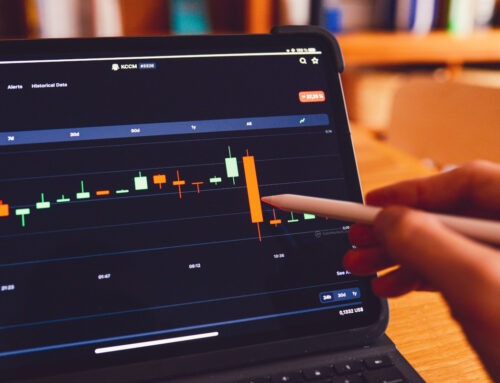Wondering how to learn swing trading quickly and easily? You’ve come to the right place. In this article, we’re going to provide you with some great resources for investors first starting out with this strategy. We’ll also explain the best way to learn swing trading. Spoiler alert – we encourage new traders to get started with paper trading before progressing to trading with a small account.
You can only learn so much through reading blog posts and watching videos. At a certain point, you have to dive in yourself and gain that experience – no matter how intimidating that first trade with cash may seem. Trust us – by the end of this article, you’ll feel confident in your ability to learn swing trading and set out on your own. Let’s begin!
Featured Courses:
What Does It Mean To “Learn” Swing Trading?
Let’s first define what it truly means to learn swing trading. To us, learning swing trading is synonymous with becoming comfortable executing trades.
Many new investors are hesitant to pull the trigger and execute their first trade – despite reading every guide on the web and watching their favorite traders stream live on YouTube daily. While they have taken in a ton of information, they haven’t truly learned how to swing trade – otherwise, they’d have the confidence to do so themselves.
Our goal today is to help you gain that confidence by providing you with the right resources and the right tools to get started. Once you understand the basic principles behind this investment strategy, and you understand how to identify opportunities – it’s far less daunting.
How Long Does It Take To Learn Swing Trading?
This isn’t something we can put a set timeline on, as it varies from person to person. Those who have experience with other styles of investing – like day trading – will pick it up much faster than someone with no prior experience. We know you’re eager to get started, though, so how long does it take to learn swing trading usually?
We’ve seen supposed experts recommend you take 6 months to learn this investing style. But, we think that is excessive. If you are serious about learning, you can read a few guides, watch a few videos, and then get started with paper trading – the best way to learn, in our opinion. It shouldn’t take you more than a month or two to feel confident enough to open your own small investing account.
How To Learn Swing Trading: Start With These Simple Guides
Ready to learn swing trading? Let’s get started with the basics. Read these quick guides for an introduction to this investing style. Then, come back and continue reading as we discuss learning through paper trading:
- What Is Swing Trading? – we’ll introduce you to this investment strategy and explain how it works.
- Swing Trading Strategies – you’ll learn the principles behind swing trading, and the strategies you must put in place in order to be successful
- Best Indicators For Swing Trading – in this article, we cover the best indicators for swing traders. You’ll learn how to identify opportunities, how to confirm their momentum, and how to get in & out of trades.
- Swing Trading With A Small Account – most swing traders get started with a small account. This is a great way to dip your toes in the water as you get more comfortable and confident – but there are a few things you need to know.
- Swing Trading Pros and Cons – learn the good, the bad, and the ugly of swing trading. We’ll compare it to other investing strategies like day trading, long-term position trading, and more.
If you are serious about learning how to swing trade, investing in a course to guide you through the steps is a great idea. We have a 6-week course that takes you from a complete beginner to an in-depth understanding of technical analysis so you can begin growing your account. We also have a basic swing trading course that will show you all the necessary tools to become a successful swing trader. Believe us when we say that paying for these courses will save you money by preventing mistakes later on. The value packed into these courses is incredible.
How To Learn Swing Trading Through Paper Trading Experience
Most people will learn more in a few weeks of paper trading than they will over a few months scouring the internet reading how-to guides. We wholeheartedly believe that the best way to learn is by doing. And with paper trading, you can simulate a real trading experience without any of the risk.
Paper trading allows you to follow in real-time with the market (sometimes with slight delays) and conduct technical analysis, monitor trends, build watch lists, etc. You can enter and exit positions, learn how to establish stop-losses and take-profit orders. Simply put, you’ll do everything a real trader does – but without having to deposit your real money. You’ll experience the highs and lows of investing. And, you’ll get a better understanding of who you are as an investor. You can get started paper-trading in the VectorVest software today – which we’ll talk more about in a moment.
It’s easy to get stuck in the paper trading phase – but eventually, you will need to take the leap and start trading a small account with real cash. When the time comes, you’ll want to invest in a stock forecasting software to help set you up for success.
Set Yourself Up For Swing Trading Success With VectorVest
These days, investing is easier than ever. A new trader can jump in with a high rate of success by using the right tools – like VectorVest.
The VectorVest stock forecasting software allows you to eliminate any guesswork, uncertainty, or emotion from investing. You can look up any given stock and we’ll present you with a clear buy, sell, or hold recommendation. Try it out yourself with a free stock analysis here!
Finding stocks to swing trade is essentially automated, too. You can pull up our pre-built searches and see which stocks we have rated the highest on any given day. Better yet, you’ll be able to quickly tell what the overall market sentiment is. If we believe a downturn is coming, you’ll be the first to know – and we’ve been calling every major market move for the last 20 years. So how does it work?
We use three proprietary ratings that simplify all technical and fundamental indicators: value, safety, and timing. These are rated on a scale from 1.00-2.00 and make investing brain-dead easy. These mathematical models have proven accurate time and time again.
So, what comes next? Now that you know how to learn swing trading, get started on some of those resources we linked earlier. Then, you can dive into paper trading with VectorVest and see what the software is all about while you gain experience executing trades. You’ll be able to see just how simple and lucrative investing can be with the help of our proprietary VST ratings.
If you want to look at data all day and hope for the best, stick with traditional investment software. But if you want answers, give VectorVest a shot and start investing with confidence – without any experience!








Leave A Comment